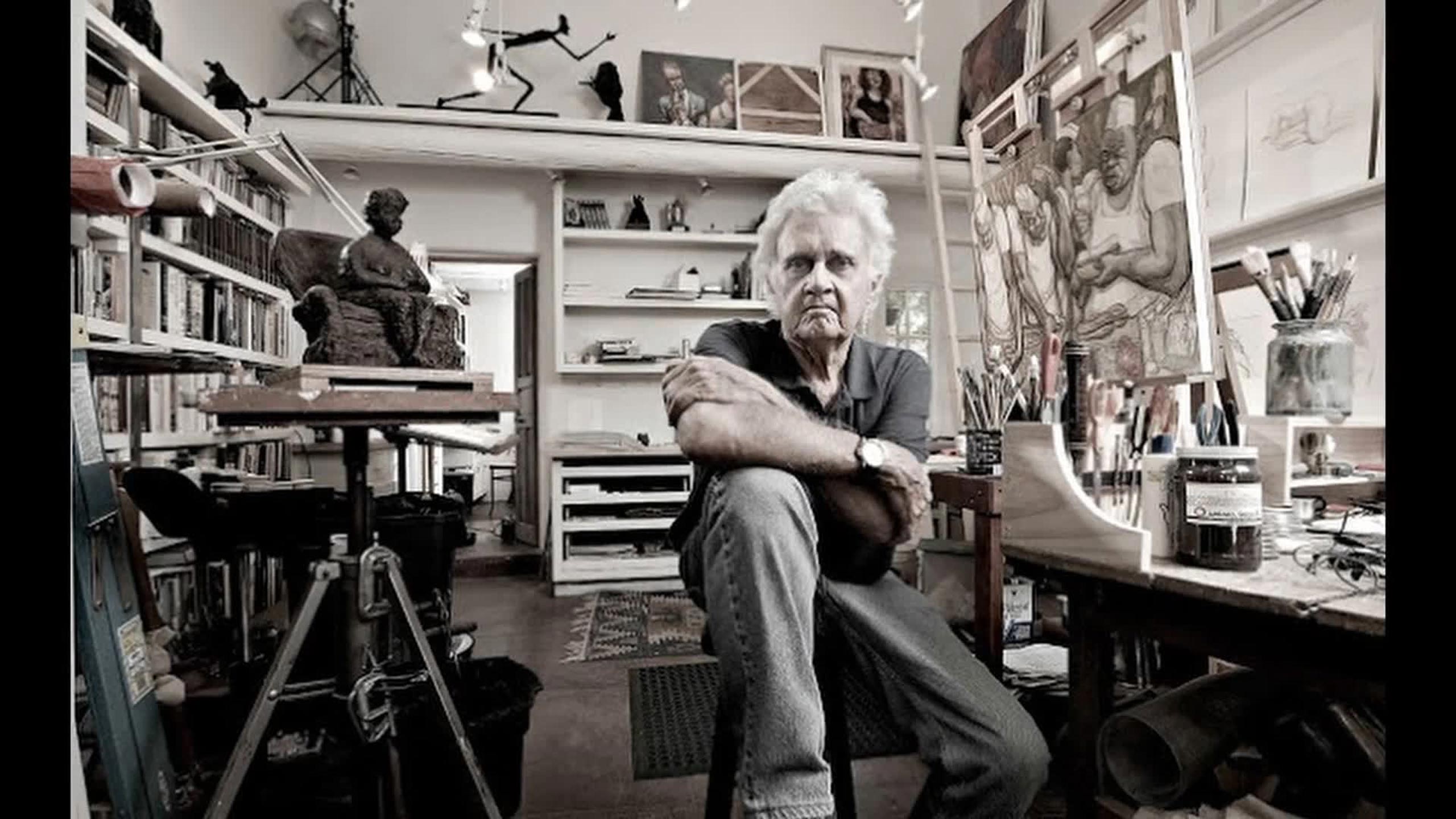
New film looks back at one of history’s greatest visual humorists who spoke truth—and mirth—to power.
As Jimmy Kimmel and Stephen Colbert undergo the slings and arrows of outrageous censorship, a timely new documentary chronicles a sketching scourge of the status quo who skewered the powers that be, lampooning politicians, oligarchs and other tyrannical targets with a pen wielded like a harpoon.
A Savage Art: The Life & Cartoons of Pat Oliphant takes a look at the Pulitzer Prize-winning artist who used the First Amendment via the visual medium of the single panel political cartoon to express sharp commentary in graphic form for about half a century, from LBJ to Trump, providing as one interviewee puts it, “a throughline to the insanity of America.”
This non-fiction film also touches upon the issue of banning artists.
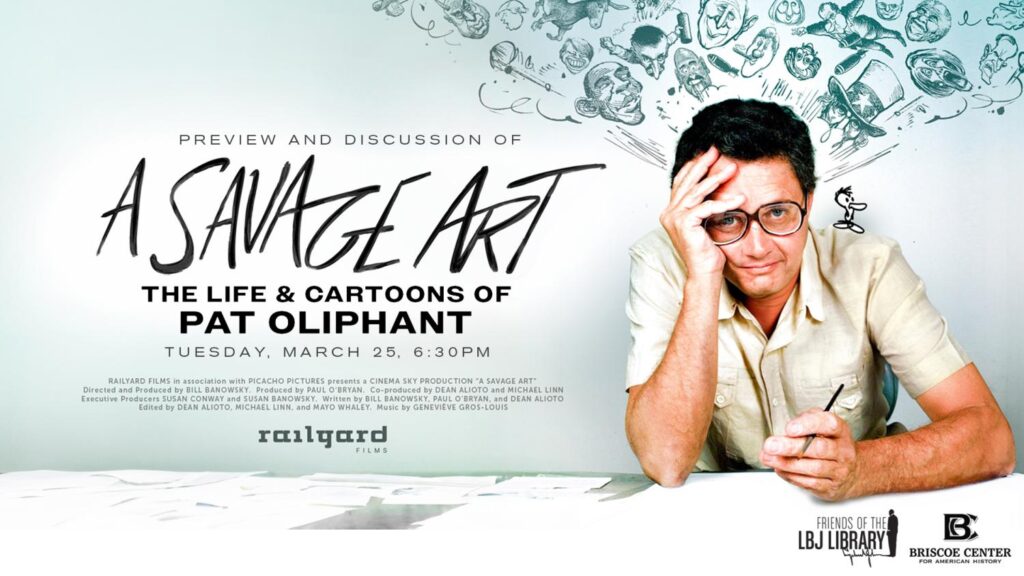

In an auspicious directorial debut, Bill Banowsky does so with great motion-picture panache, cinematically capturing the wit and righteous outrage of Oliphant’s art, as well as his singular personality.
A Savage Art opens with a rapid-fire montage that includes many of Oliphant’s editorial cartoons, set to Edvard Grieg’s “In the Hall of the Mountain King,” music for a scene in Henrik Ibsen’s play Peer Gynt which, appropriately, includes trolls, gnomes and goblins.
It may surprise those already familiar with Oliphant to learn that this acute, acerbic observer of the American scene was not born in the United States but, rather, in South Australia, near the state capital of Adelaide, in 1935.
However, having worked for the Australian Broadcasting Corp. and traveled Down Under several times, this makes perfect sense to me because many Australians have a healthy sense of irreverence and skepticism (particularly when it comes to the Yanks).
In addition, living in a country that is not originally your homeland can provide one with a sense of ironic detachment about an adopted country where the transplant may be in it, but not of it.
Speaking of irony, while still an adolescent, the iconoclastic Oliphant began his journalistic path as a copy boy, working for none other than Rupert Murdoch at The News, Adelaide’s evening tabloid.

And given that Pat went on to use his pen to decry war, it is also quite ironic that his uncle, physicist Mark Oliphant, worked on the Manhattan Project with Robert Oppenheimer. Pat would go on to parody nuclear weapons and the arms race, as well as the Cold War, in his stinging anti-war images.
To be closer to the center of world events, Oliphant left the relative backwaters of Australia and relocated to the U.S. in 1964 to work as the Denver Post’s editorial cartoonist. About a decade later he moved on to the epicenter of American if not world politics, Washington, D.C., and soon, instead of working from the home base of a specific newspaper, Oliphant—who chafed at the bit by being told what to draw/say—chose to pursue syndication of his work, which enabled him to exercise editorial control and independence, a crucial component for artists.
Oliphant was a bipartisan, equal opportunity offender, who poked and prodded Democrats and Republicans alike, with equal disdain for both.
For example, in one cartoon Alice in Wonderland’s twin brothers Tweedledee and Tweedledum represent the two parties.
The first American president the newly arrived immigrant regularly caricatured was Democrat Lyndon Baines Johnson, especially as Oliphant was critical of the Vietnam War. Later in A Savage Art Oliphant says in voiceover that he “really didn’t take to Clinton. There’s something see-through-able about him. He never really convinced me of his sincerity.”
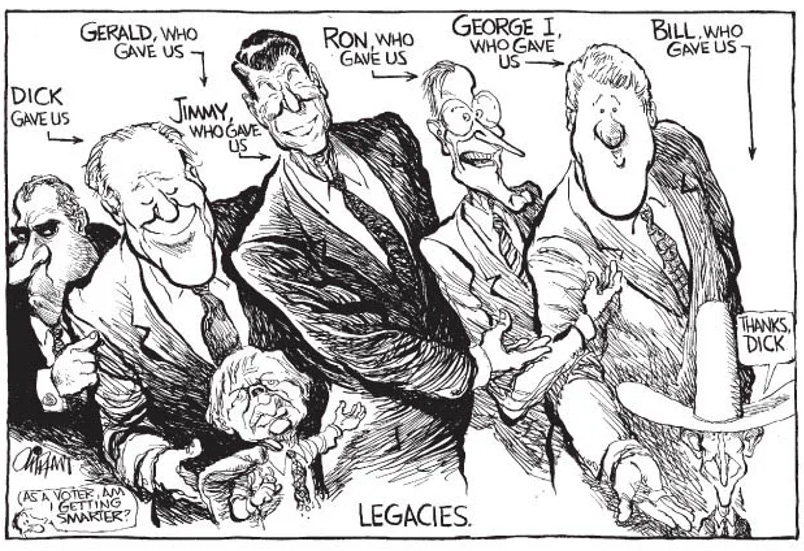
Caricatures of Clinton, also a Democrat, dancing the old soft shoe, or with his alleged paramours, Paula Jones and Monica Lewinsky, appear on the screen and we hear Clinton’s lame denials of his committing adultery, followed by his confession, with images of Hillary hurling anvils at her unfaithful, mendacious husband.
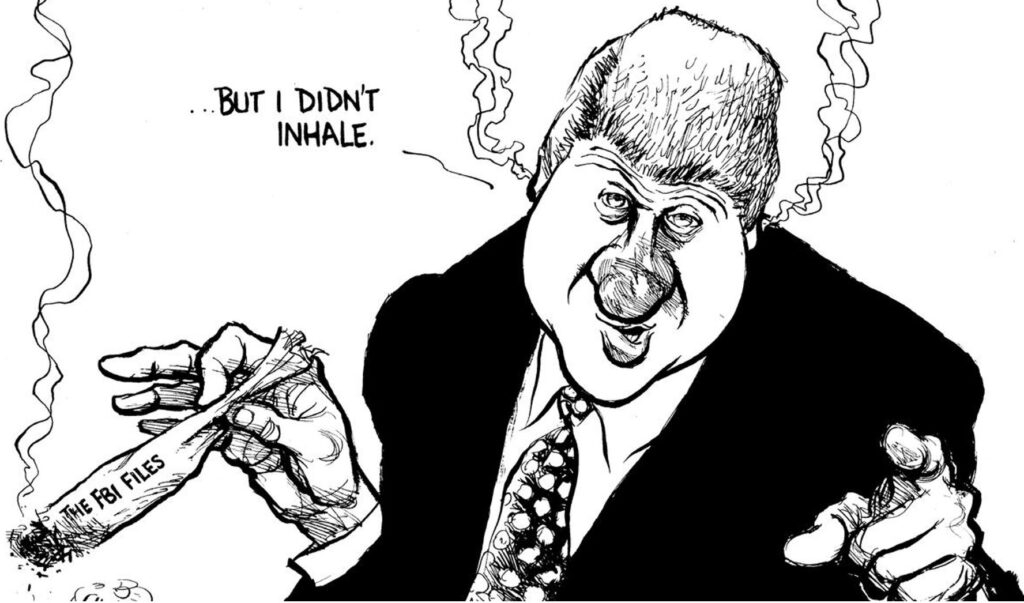
In a panel drawn during the Obama administration, an oversized Benjamin Netanyahu, marked with a Star of David, points a finger and glares at a glum, seated President Barack Obama, snarling: “You don’t seem to understand who is in charge here.”

Another cartoon has Obama holding open a book entitled “Enemies” and Barack smiles at Nixon, who tells the Democrat: “Benghazi, I.R.S., A.P., Justice – you’re doing beautifully, son… May I call you ‘son’?”
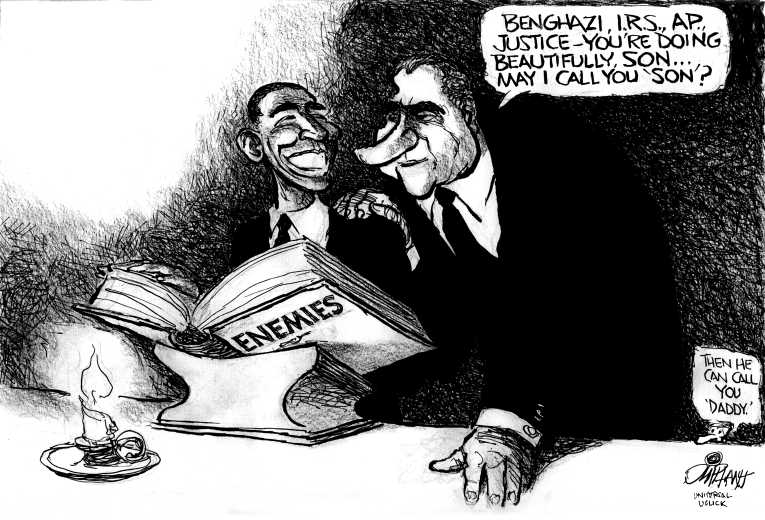
The cartoonist had a special animus toward the GOP’s President Richard Nixon, Oliphant’s bête noire, the man he loved to hate, who was drawn as jowly, increasingly sinister, with Nixon’s head on the body of a rat, roach or spider.
Often, Nixon appears naked, which may be the satirist’s reference to the emperor not wearing any clothes. Onscreen, Oliphant describes Tricky Dick as “a gift, he was a sort of an ally to cartoonists.”

Other favorite targets included President Ronald Reagan and Vice President Dick Cheney, while his first newspaper boss Rupert Murdoch receives special mentions, too.
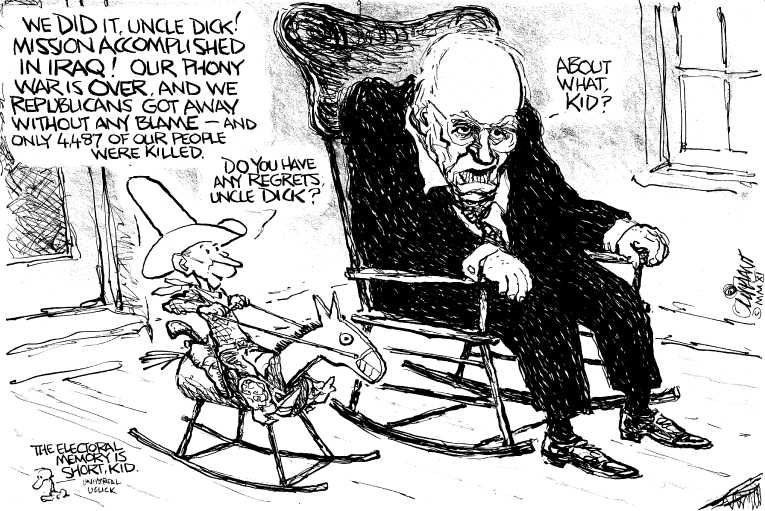
World affairs also captured Oliphant’s attention, such as his series on apartheid in South Africa. In a cartoon captioned “State of Emergency,” a boot labeled South Africa is crushing a Black man. Oliphant also turned his ire toward the Middle East, with (as aforementioned) a special disdain for Bibi Netanyahu.
In a couple of his cartoons, the Star of David—which is a religious symbol but is also emblazoned on the flag of the State of Israel—is depicted in unflattering ways, on the side of a dog urinating on Uncle Sam, or the Star of David forming a shark’s fanged mouth, being wheeled toward a woman with a baby by a jackbooted, sword-waving soldier.
A Savage Art explores Oliphant’s artistry which, in addition to roughly 10,000 editorial cartoons, included sculpting and painting, and delves into the artist’s creative process.
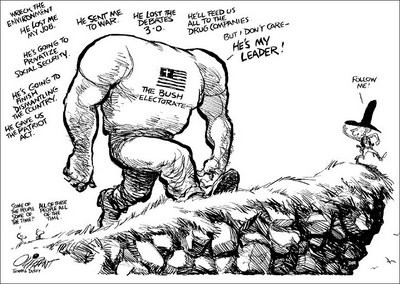
Oliphant would study the presidents and derive a visual detail, or what he called “a trademark,” that summed them up. The satirist always drew President Gerald Ford, who was widely ridiculed for his stumbling, with a band aid on his forehead.
As an employee, Oliphant had brushes with censorship and, although he won a Pulitzer Prize for it, he rued a cartoon depicting Ho Chi Minh holding a dead Vietnamese, in part because an editor the cartoonist disparaged as a “cigar chewing asshole who was drunk most of the time,” changed the caption, altering “peace table” to “conference table,” which defanged the piece’s bite.
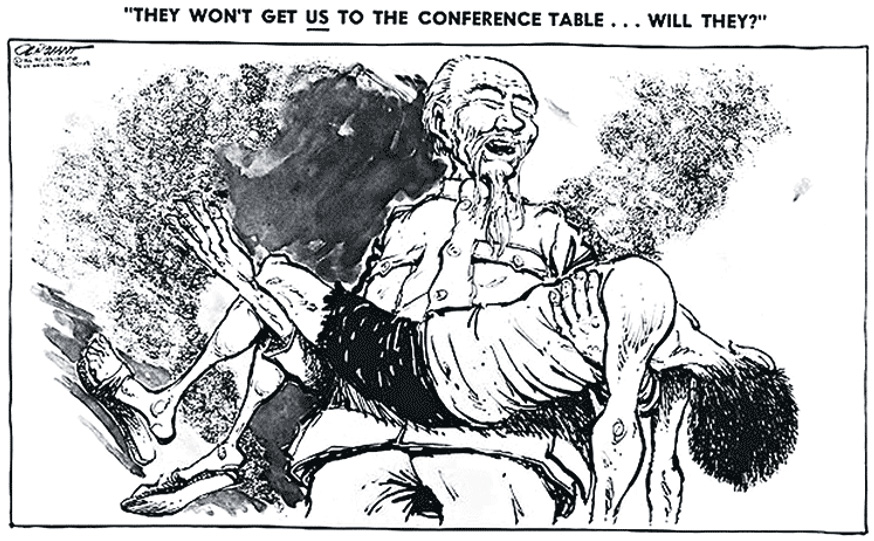
In a section on the history of political cartoons, the art form’s practitioners incurred the wrath of France’s Prince Louis-Philippe I, and an unflattering image of His Majesty is shown, which Oliphant says earned Honoré Daumier six months behind bars in 1832.

Later, A Savage Art the documentary returns to the subject of censorship with a section on Rob Rogers, whose color cartoons excoriating President Donald Trump led to his neck going on the Trumpian chopping block, seven years before Kimmel and Colbert faced the MAGA firing squad.
After decades as the Pittsburgh Post-Gazette’s cartoonist, Rogers was axed in 2018.
The film also remembers the cartoonists and staffers of France’s Charlie Hebdo magazine who were butchered by religious zealots in 2015 (religious fanaticism of every denomination is another big bugaboo for Oliphant).
As the Wall Street Journal’s Eric Gibson points out onscreen, those who take themselves far too seriously cannot stand to be mocked. Another of the film’s commentators says that “hate mail is high congratulation that you’ve hit your target.”

Late in his career Oliphant trained his ire on Trump. In one panel, garbed in a Nazi uniform with a swastika armband, Mein Trumpf looks in a mirror and asks “Herr Bannon” how he looks, to which a Sieg Heiling Steve Bannon replies: “Exquisite as usual, Herr Trump!”

But what has stopped the cartooning of Pat Oliphant—who turned 90 this year—is the greatest censor of them all: The vicissitudes of old age. The man who moved across the world to be near the rooms where it happened relocated far from the madding crowd to Santa Fe, New Mexico, in 2004.
Another hobgoblin Oliphant tackled was gun violence. An image created long before conservative influencer’s Charlie Kirk’s murder seems especially apropos of that shooting death:
Three statues marked “The Executive,” “The Legislative,” and “The Judicial,” hold up a roof labeled “The Four Pillars of U.S. Government.” The skewed, fourth pillar depicts a deranged gunman and is entitled “The Armed Maniac.”
This is followed onscreen by an image of a mother waving an automatic weapon, as she runs toward her little daughter who is about to board a school bus, shouting: “Tina Honey! You forgot your assault weapon!”
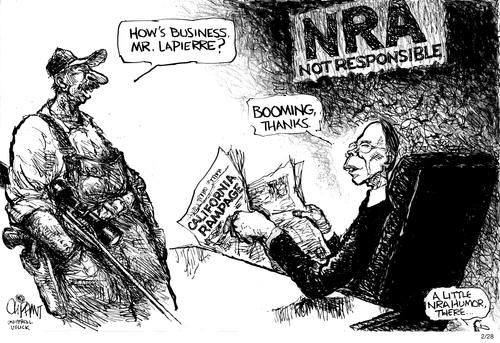
A Savage Art: The Life & Cartoons of Pat Oliphant, in the section on the history of political cartooning, includes information on how technological developments have impacted the medium, along with overviews of great cartoonists such as Daumier and Thomas Nast.
Period footage and news clips are fluidly and creatively interwoven with the cartoon imagery and original interviews throughout this 88-minute documentary that covers lots of ground. In archival footage, columnist Maureen Dowd delivers a speech lauding Oliphant (who did the cover art for Dowd’s 2004 book Bushworld) at a dinner, and there are original interviews with former Senator Tom Udall plus members of Oliphant’s family, so we learn about the private side of a public figure.
Editorial cartoonists, too, are interviewed onscreen, including Ed Sorel, Adam Zyglis and Ann Telnaes, the Pulitzer Prize winner who quit The Washington Post last January after an editor rejected her cartoon depicting tech billionaires—including Post owner Jeff Bezos—offering money and bowing down before a statue of Trump, with Mickey Mouse prostrate on its pedestal.
The topic of political cartoonists as an endangered species is also discussed in this trenchant film.
Director/co-writer Banowsky previously produced documentaries such as 2010’s Casino Jack and the United States of Money, which is about lobbyist Jack Abramoff and was directed by Alex Gibney.
My one criticism of Banowsky’s briskly paced film that never lags is that sometimes there is not enough time to read the cartoons’ captions.
Other than that minor quibble, the cinematic Savage Art is a highly entertaining, enlightening, educational look at an exceptional artist and, through his work, at the medium of political cartooning.
It is also extremely of the moment, coming at a time when truth-telling TV humorists cracking wise about political topics are being subjected to the crack of the censor’s whip. See it while it is still legal to do so, before Trump pulls it from distribution.
As of this writing, A Savage Art: The Life & Cartoons of Pat Oliphant is playing in theaters. For screenings see: https://www.magpictures.com/asavageart/screenings/.

CovertAction Magazine is made possible by subscriptions, orders and donations from readers like you.
Blow the Whistle on U.S. Imperialism
Click the whistle and donate
When you donate to CovertAction Magazine, you are supporting investigative journalism. Your contributions go directly to supporting the development, production, editing, and dissemination of the Magazine.
CovertAction Magazine does not receive corporate or government sponsorship. Yet, we hold a steadfast commitment to providing compensation for writers, editorial and technical support. Your support helps facilitate this compensation as well as increase the caliber of this work.
Please make a donation by clicking on the donate logo above and enter the amount and your credit or debit card information.
CovertAction Institute, Inc. (CAI) is a 501(c)(3) non-profit organization and your gift is tax-deductible for federal income purposes. CAI’s tax-exempt ID number is 87-2461683.
We sincerely thank you for your support.
Disclaimer: The contents of this article are the sole responsibility of the author(s). CovertAction Institute, Inc. (CAI), including its Board of Directors (BD), Editorial Board (EB), Advisory Board (AB), staff, volunteers and its projects (including CovertAction Magazine) are not responsible for any inaccurate or incorrect statement in this article. This article also does not necessarily represent the views the BD, the EB, the AB, staff, volunteers, or any members of its projects.
Differing viewpoints: CAM publishes articles with differing viewpoints in an effort to nurture vibrant debate and thoughtful critical analysis. Feel free to comment on the articles in the comment section and/or send your letters to the Editors, which we will publish in the Letters column.
Copyrighted Material: This web site may contain copyrighted material the use of which has not always been specifically authorized by the copyright owner. As a not-for-profit charitable organization incorporated in the State of New York, we are making such material available in an effort to advance the understanding of humanity’s problems and hopefully to help find solutions for those problems. We believe this constitutes a ‘fair use’ of any such copyrighted material as provided for in section 107 of the US Copyright Law. You can read more about ‘fair use’ and US Copyright Law at the Legal Information Institute of Cornell Law School.
Republishing: CovertAction Magazine (CAM) grants permission to cross-post CAM articles on not-for-profit community internet sites as long as the source is acknowledged together with a hyperlink to the original CovertAction Magazine article. Also, kindly let us know at info@CovertActionMagazine.com. For publication of CAM articles in print or other forms including commercial internet sites, contact: info@CovertActionMagazine.com.
By using this site, you agree to these terms above.
About the Author

Ed Rampell is an L.A.-based film historian and critic who also reviews culture, foreign affairs and current events.
Ed can be reached at edrampel@gte.net.

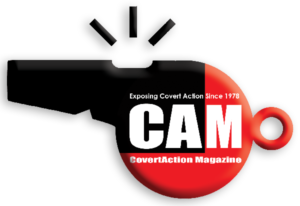
Evelyn should get out more, read Israel’s history and basically apply some common sense.
Hamas operatives behind every dead 70,000 Gazans (officially, but no doubt 100,000 plus)?
‘Hamas using civilians as human shields’ is a straight out hasbara lie.
CAMERA is a hasbara outfit established to burnish the image of a rogue terrorist state.
As are UN Watch, the Middle East Media Research Institute, Honest Reporting, StandWithUs, Hasbara Fellowships, NGO Monitor, Israel at Heart, Israel on Campus Coalition, Campus Watch, Coalition of Hasbara Volunteers, and Act.IL, etc.
Meanwhile, on the West Bank, Hamas is using olive trees as inhuman shields, hence the necessity to cut down all olive trees.
Excellent article. Very well written. I might add While Oliphant has consistently criticized Israeli policies, sometimes in ways that have deeply offended its supporters, critics have argued that his cartoons often focus heavily on Israeli actions while ignoring Palestinian terrorism and the role of Hamas in using civilians as human shields. Organizations like CAMERA (Committee for Accuracy in Middle East Reporting in America) have argued that Oliphant’s depictions are biased and lack the context of ongoing rocket attacks from Gaza into Israel.